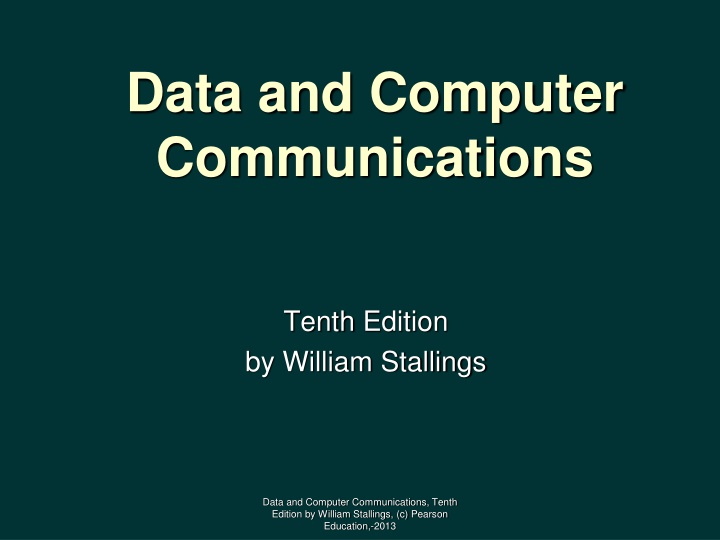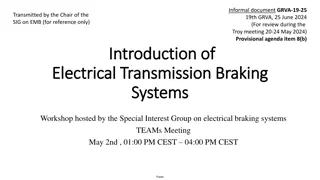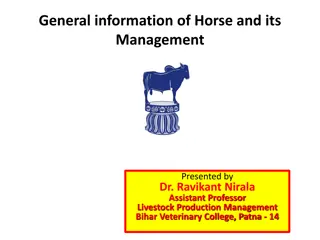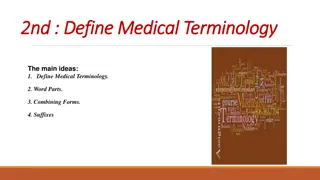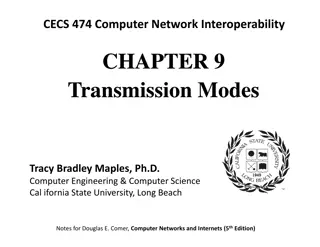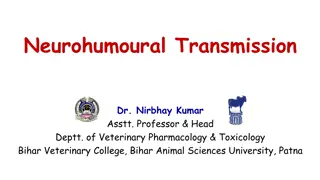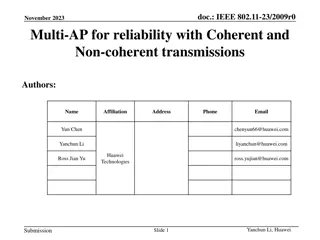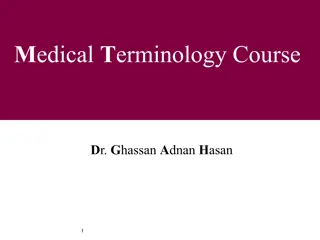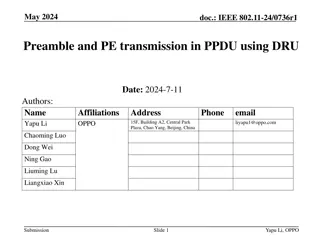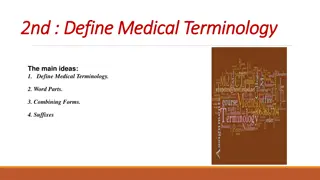Data Transmission Fundamentals and Terminology
In this comprehensive guide, explore the foundational concepts of data transmission, including key terminology, signal types, and transmission mediums. Delve into topics such as simplex, half-duplex, and full-duplex communication, analog versus digital waveforms, and examples of periodic signals like sine and square waves. Gain insights into the essential parameters of signals and the nature of electromagnetic wave propagation through various media. Enhance your understanding of data and computer communications with this informative resource.
Download Presentation

Please find below an Image/Link to download the presentation.
The content on the website is provided AS IS for your information and personal use only. It may not be sold, licensed, or shared on other websites without obtaining consent from the author.If you encounter any issues during the download, it is possible that the publisher has removed the file from their server.
You are allowed to download the files provided on this website for personal or commercial use, subject to the condition that they are used lawfully. All files are the property of their respective owners.
The content on the website is provided AS IS for your information and personal use only. It may not be sold, licensed, or shared on other websites without obtaining consent from the author.
E N D
Presentation Transcript
Data and Computer Communications Tenth Edition by William Stallings Data and Computer Communications, Tenth Edition by William Stallings, (c) Pearson Education,-2013
CHAPTER 3 Data Transmission
I have been trying to prove the following theorem: for any operators T,R the length of an arbitrary message f1 multiplied by its essential spectrum and divided by the distortion of the system is less than a certain constant times the time of transmission of F multiplied by its essential spectrum width or roughly speaking it is impossible to reduce bandwidth times transmission time for a given distortion. This seems to be true although I do not have a general proof as yet. Letter to Vannevar Bush, February 16, 1939, from Claude Shannon
Transmission Terminology Data transmission occurs between transmitter and receiver over some transmission medium Communication is in the form of electromagnetic waves Guided media Unguided media (wireless) Propagation through air, vacuum, and seawater Twisted pair, coaxial cable, optical fiber
TransmissionTerminology Simplex Signals are transmitted in only one direction One station is transmitter and the other is receiver Half duplex Both stations transmit, but only one at a time Full duplex Both stations may transmit simultaneously The medium is carrying signals in both directions at the same time
Amplitude (volts) Time (a) Analog Amplitude (volts) Time (b) Digital Figure 3.1 Analog and Digital Waveforms
A Amplitude (volts) 0 Time A period = T = 1/f (a) Sine wave A Amplitude (volts) 0 Time A period = T = 1/f (b) Square wave Figure 3.2 Examples of Periodic Signals
Sine Wave Is the fundamental periodic signal Can be represented by three parameters Peak amplitude (A) Maximum value or strength of the signal over time Typically measured in volts Frequency (f) Rate at which the signal repeats Hertz (Hz) or cycles per second Period (T) is the amount of time for one repetition T = 1/f Phase ( ) Relative position in time within a single period of signal
Wavelength ( ) The wavelength of a signal is the distance occupied by a single cycle Can also be stated as the distance between two points of corresponding phase of two consecutive cycles Especially when v=c c = 3*108 m/s (speed of light in free space) Assuming signal velocity v, then the wavelength is related to the period as = vT Or equivalently f = v
Frequency Domain Concepts Signals are made up of many frequencies Components are sine waves Fourier analysis can show that any signal is made up of components at various frequencies, in which each component is a sinusoid Can plot frequency domain functions
Data Rate and Bandwidth Any transmission system has a limited band of frequencies This limits the data rate that can be carried on the transmission medium Square waves have infinite components and hence an infinite bandwidth Limiting bandwidth creates distortions Most energy in first few components There is a direct relationship between data rate and bandwidth
Analog and Digital Data Transmission Data Signals Signaling Transmission Physical propagation of the signal along a suitable medium Communication of data by the propagation and processing of signals Electric or electromagnetic representations of data Entities that convey information
Upper modulating frequency for FM radio Upper modulating frequency for AM radio Telephone channel 0 Music Power Ratio in Decibels 20 Speech Approximate dynamic range of music Approximate dynamic range of voice 30 dB 40 Noise 60 10 Hz 100 Hz 1 kHz 10 kHz 100 kHz Frequency Figure 3.9 Acoustic Spectrum of Speech and Music [CARN99]
Digital Data Character strings Text Examples: IRA
Voltage at transmitting end Voltage at receiving end Figure 3.10 Attenuation of Digital Signals
Advantages and Disadvantages of Digital Signals
In this graph of a typical analog voice signal, the variations in amplitude and frequency convey the gradations of loudness and pitch in speech or music. Similar signals are used to transmit television pictures, but at much higher frequencies. Figure 3.11 Conversion of Voice Input to Analog Signal
To produce a video signal a TV camera is used USA standard is 483 lines per frame, at a rate of 30 complete frames per second Video Signals Actual standard is 525 lines but about 42 are lost during vertical retrace Horizontal scanning frequency is 525 lines x 30 scans = 15750 lines per second Max frequency if line alternates between black and white as rapidly as possible
0 1 1 1 0 0 0 1 0 1 +5 volts 5 volts 0.02 msec User input at a PC is converted into a stream of binary digits (1s and 0s). In this graph of a typical digital signal, binary one is represented by 5 volts and binary zero is represented by +5 volts. The signal for each bit has a duration of 0.02 msec, giving a data rate of 50,000 bits per second (50 kbps). Figure 3.12 Conversion of PC Input to Digital Signal
Analog Signals: Represent data with continuously varying electromagnetic wave Analog Data (voice sound waves) Analog Signal Telephone Digital Data (binary voltage pulses) Analog Signal (modulated on carrier frequency) Modem Digital Signals: Represent data with sequence of voltage pulses Digital Signal Analog Data Codec Digital Data Digital Signal Digital Transceiver Figure 3.13 Analog and Digital Signaling of Analog and Digital Data
Table 3.1 Analog and Digital Transmission
Move to Digital Digital technology LSI and VLSI technology has caused a continuing drop in the cost and size of digital circuitry Data integrity The use of repeaters has made it possible to transmit data longer distances over lower quality lines while maintaining the integrity of the data Capacity utilization It has become economical to build transmission links of very high bandwidth, including satellite channels and optical fiber, and a high degree of multiplexing is needed to utilize such capacity effectively Security and privacy Encryption techniques can be readily applied to digital data and to analog data that have been digitized Integration Economies of scale and convenience can be achieved by integrating voice, video, and digital data
Asynchronous and Synchronous Transmission Asynchronous Strategy is to avoid the timing problem by not sending long, uninterrupted streams of bits Data are transmitted one character at a time, where each character is 5 to 8 bits in length Timing or synchronization must only be maintained within each character The receiver has the opportunity to resynchronize at the beginning of each new character Synchronous A block of bits is transmitted in a steady stream without start and stop codes Block may be many bits in length To prevent timing drift between transmitter and receiver, their clocks must somehow be synchronized Provide a separate clock line between transmitter and receiver Embed the clocking information in the data signal Frame Data plus preamble, postamble, and control information
Transmission Impairments Signal received may differ from signal transmitted causing: Analog - degradation of signal quality Digital - bit errors Most significant impairments are Attenuation and attenuation distortion Delay distortion Noise
Received signal strength must be: Strong enough to be detected Sufficiently higher than noise to be received without error Equalize attenuation across the band of frequencies used by using loading coils or amplifiers Strength can be increased using amplifiers or repeaters ATTENUATION Signal strength falls off with distance over any transmission medium Varies with frequency
10 1 Without equalization Attenuation (decibels) relative to attenuatoin at 1000 Hz 5 0 2 With equalization 5 0 500 1000 1500 2000 2500 3000 3500 Frequency (Herz) (a) Attenuation 4000 Relative envelope delay (microseconds) 1Without equalization 3000 2000 1000 2With equalization 0 0 500 1000 1500 2000 2500 3000 3500 Frequency (Herz) (b) Delay distortion Figure 3.14 Attenuation and Delay Distortion Curves for a Voice Channel
Delay Distortion Occurs in transmission cables such as twisted pair, coaxial cable, and optical fiber Does not occur when signals are transmitted through the air by means of antennas Occurs because propagation velocity of a signal through a guided medium varies with frequency Various frequency components arrive at different times resulting in phase shifts between the frequencies Particularly critical for digital data since parts of one bit spill over into others causing intersymbol interference
Noise Unwanted signals inserted between transmitter and receiver Is the major limiting factor in communications system performance
Categories of Noise Crosstalk: A signal from one line is picked up by another Can occur by electrical coupling between nearby twisted pairs or when microwave antennas pick up unwanted signals Impulse Noise: Caused by external electromagnetic interferences Noncontinuous, consisting of irregular pulses or spikes Short duration and high amplitude Minor annoyance for analog signals but a major source of error in digital data
Channel Capacity Maximum rate at which data can be transmitted over a given communications channel under given conditions Bandwidth Error rate The bandwidth of the transmitted signal as constrained by the transmitter and the nature of the transmission medium, expressed in cycles per second, or hertz Data rate Noise The rate at which errors occur, where an error is the reception of a 1 when a 0 was transmitted or the reception of a 0 when a 1 was transmitted The main constraint on achieving efficiency is noise The greater the bandwidth of a facility, the greater the cost The rate, in bits per second (bps) at which data can be communicated The average level of noise over the communications path
Nyquist Bandwidth In the case of a channel that is noise free: The limitation of data rate is simply the bandwidth of the signal If the rate of signal transmission is 2B then a signal with frequencies no greater than B is sufficient to carry the signal rate Given a bandwidth of B, the highest signal rate that can be carried is 2B For binary signals, the data rate that can be supported by B Hz is 2B bps With multilevel signaling, the Nyquist formula becomes: C = 2B log2M Data rate can be increased by increasing the number of different signal elements This increases burden on receiver Noise and other impairments limit the practical value of M
Shannon Capacity Formula Considering the relation of data rate, noise and error rate: Faster data rate shortens each bit so bursts of noise corrupts more bits Given noise level, higher rates mean higher errors Shannon developed formula relating these to signal to noise ratio (in decibels) SNRdb=10 log10 (signal/noise) Capacity C = B log2(1+SNR) Theoretical maximumcapacity Get much lower rates in practice
SNRdB 0 30 20 10 10 20 30 10 Spectral efficiency (bps/Hz) 1 0.1 0.01 0.001 0.001 0.10 0.1 1 10 100 1000 SNR Figure 3.16 Spectral Efficiency versus SNR
Summary Transmission terminology Frequency, spectrum, and bandwidth Analog and digital data transmission Transmission impairments Attenuation Delay distortion Noise Channel capacity Analog and digital data Nyquist bandwidth Analog and digital signals Shannon capacity formula Analog and digital transmission The expression Eb/No Asynchronous and synchronous transmission
